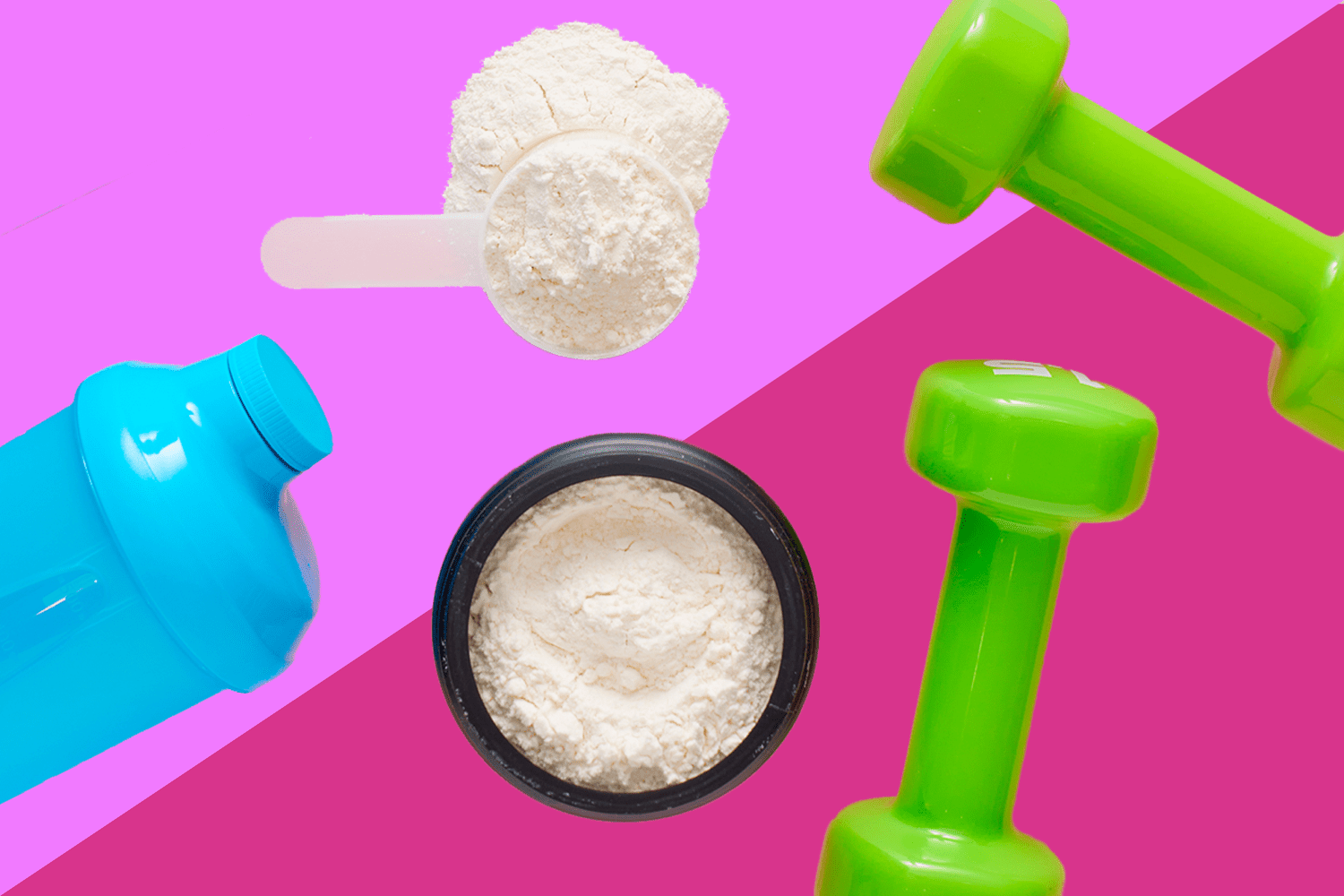Optimal Protein Intake for Muscle Growth

If you’ve been busting your butt in the gym and still not getting any fitter, you’re probably wondering what gives. It turns out the culprit could be inadequate protein intake.
When you’ve got fitness goals, what you eat outside of the gym is just as important as what you do in it. In particular, how much protein you get each day matters. “Adequate protein intake is essential for everyone, but especially for people who exercise and lift regularly, as protein helps rebuild the muscles that are broken down during this type of activity,” says dietitian and exercise physiologist Jim White, R.D.N., owner of Jim White Fitness & Nutrition Studios. He says that failing to get enough protein can lead to poor recovery, feelings of fatigue during and after your workout, and an increased risk of injury, all of which can send you right into an exercise plateau.
So, how much protein do you need if you exercise and want to reduce the likelihood of a plateau? Read on to find out. Ahead, sports nutritionists break down why protein is such an essential macronutrient for people who regularly break a sweat. Plus, share eight tips for helping you meet your protein needs.
Whether you’re strength training or running, doing hatha yoga or hiking, tiny microscopic tears get shown into your muscle tissues when you exercise with any intensity. After you leave the gym or studio or take off your trainers, special fixer-upper cells (called satellite cells) signal the body that it’s time to get to work triaging the tears. From here, the body plugs amino acids, the building blocks of protein, into the damaged spots, which ultimately leaves your muscle tissues stronger than before you broke a sweat, explains Kylene Bogden, M.S., R.D.N., C.S.S.D., I.F.N.C.P., co-founder of FWDFuel Sports Nutrition.
Broadly speaking, the more you exercise, the more protein you need because “without adequate protein intake, our body does not have the nutrients it needs to rebuild,” she says. The result? Your muscles remain in a broken-down state, meaning you never actually get to the speed, strength, or stamina gains your fitness routine should lend itself to. Because your muscles are never fully healed, you’ll also always be sore and be at increased risk of exercise-related injury, says sports dietitian Angie Asche, MS, RD, CSSD. It's not ideal for anyone who wants to feel good, not just look good.
Protein also supports overall energy levels, so it is common for individuals to feel uncharacteristically tired and weak if they aren’t getting enough protein, says Asche. For gym-goers, this can manifest in feeling more wiped than they felt after the same exercise routine weeks early, as well as increased fatigue immediately following gym time. Do you always need couch time after working out? It may be time to reevaluate your protein intake.
Long-term, inadequate intake increases the risk of sports-related injury and, in extreme instances, may lead to overtraining syndrome. In fact, one study published in the journal Nutrients found that boosting protein intake can reduce the risk of injury in combat sports. At the same time, another study also published in Nutrients suggests that increasing protein after an injury can speed up healing.
Yes, if you’re an exerciser who is not getting enough protein, your (worsened) performance will let you know. The good news is that some other signs of inadequate protein intake usually pop up before you reach that point. Phew.
One of the first signs of protein deficiency is brittle hair and nails, according to Sarah Wragge, a holistic health expert. When you’re not getting enough protein and amino acids from food, your body will start to break down the already-existing proteins in the body, such as those found in the hair and nails, she explains. The reduced amount of protein in your hair and nails results in their thinning, which increases the risk of breakage, she says. As such, breaking nails left and right and noticing more split ends or hair in the drain are signs that it’s time to consider your exercise routine.
Protein intake also supports overall satiety, according to Bogden. “It takes longer to digest and break down compared to carbohydrates, which means it keeps you full for longer,” she says. So, it’s common for people who are protein deficient to constantly feel hungry and unsatisfied, even after meals, says Asche. Because protein supports your energy, inadequate protein intake can also lead to outward grumpiness and lower mood, she adds—though this may not be discernible to people with pre-existing mental health conditions, or who are going through a stressful period.
The Recommended Daily Allowance (RDA) of protein for healthy adults is 0.36 grams of protein per every pound of body weight. According to these recommendations, a 140-pound person needs just 50 grams daily, while someone weighing 200 pounds needs approximately 72 total grams. Meanwhile, the Centers for Disease Control and Prevention (CDC) recommends just 46 grams for women and 56 grams for men daily, which you can obtain by eating just 6 or 7 ounces of chicken, respectively.
According to dietitian and strength coach Albert Matheny, R.D., C.S.C.S., COO of ARENA and co-founder of SoHo Strength Lab in New York City, most people need far more protein per day than these guidelines suggest. And people with certain health and fitness goals certainly do. “The general guidelines are extremely low and are based on the amount that is going to stop deficiency for the medium portion of the population,” he says. They measure the lowest possible amount most people can take in without consequences. “[The recommended protein levels] aren’t, however, the correct amount for optimal health nor for reaching your fitness goals,” he says.
While you probably need more protein per day than the RDA or CDC suggest, according to Asche, exactly how much more you need varies from person to person. “How much you need is not one-size-fits-all,” she says. “Many factors affect your daily protein needs, including age, physical activity, fitness, and health goals.” However, she says your current physical activity level, body composition, and fitness goals are probably the most influential factors in how much protein you need each day. Again, that’s because protein is essential for muscle growth, repair, and maintenance.
So what’s the magic number? For anyone who regularly lifts weights or is training for an endurance event, it’s 0.5 to 0.8 grams of protein per pound of body weight, according to the American College of Sports Medicine. That equates to 70 to 112 grams of protein per day for someone who weighs 140 pounds and 100 to 160 grams for someone who weighs 200 pounds.
That said, older folks who exercise may need even more than that. Why? Well, muscle mass gradually decreases 3 to 8 percent per decade after age 30, with adults older than 65 experiencing an even faster decline. The underlying cause is that the body processes protein less efficiently as it ages. Notably, women may lose muscle mass faster than men do following menopause, according to Asche. That’s because both estrogen and testosterone levels decline during menopause, which has been shown to have detrimental impacts on muscle reserves, she says.
Muscle mass supports various wellness components, including balance, locomotion (aka walking), stamina, independence, and physical resilience. As such, it’s important for aging individuals to slow this decline as much as possible with increased protein consumption, she says. According to research published in the Current Opinion in Clinical Nutrition & Metabolic Care, ingesting 25 to 30 grams of high-quality protein at every meal can help older adults preserve muscle mass by stimulating muscle protein synthesis, which produces new muscle. Whether or not that amount (approximately 75 to 90 grams over the course of the day) is adequate will also depend on your overall activity level and current body weight.
Ultimately, the best way to know how much protein you’d personally benefit from is to consult a sports nutritionist who can assess your overall training volume and type and consider factors like general health, body composition, and age.
Now that you know that getting too little protein can harm your well-being and fitness performance, you probably want to know if going too far in the other direction is possible. Technically speaking, it is possible to consume too much protein. According to the National Kidney Foundation, chronic protein over-consumption may harm the kidneys, which remove the byproducts created when protein gets broken down into its building block (amino acids).
However, according to Matheny, you have to consume way more protein than you probably currently are for these side effects. “If you eat more protein than your body needs for muscle repair and other essential functions, your body will just break it down and use it for energy in a similar way to how it uses carbohydrates,” he says.
So, what’s the protein-intake sweet spot? The specific number varies based on your goals, age, and other factors. But you can consume up to 1 gram of protein per pound of body weight daily, and trust you’re not risking your health. One 2018 study published in the journal Nutrients found it’s safe to consume 0.72 to 1.0 grams of protein per pound of body weight and that athletes would benefit from eating at the higher end. Notably, another small study published in the Journal of Nutrition & Metabolism looked at what would happen if people ate up to 1.5 grams of protein per pound of body weight every day for one year and found that there were zero harmful effects on measures of blood lipids as well as liver and kidney function.
No doubt, eating plain chicken, egg whites, and tuna fish is one (reliable) way to boost overall protein intake, but it isn’t the only way. If you’re looking for a new and improved way to add more protein to your day in the name of gains, read on for some helpful tips.
If you’re a carnivore or omnivore, odds are you already eat meat. Well, rather than overhauling your diet, Asche suggests choosing leaner cuts of the same types of meat and poultry you already know you like and know how to cook. “Even if you eat the same portion, this move will provide more protein per ounce,” she says.
Oh, and don’t sleep on beef jerky and other dried meat alternatives. “Jerky is a great travel-friendly way to get high protein animal products on the go,” says Matheny. Epic Provisions, Krave, and Archer are popular options amongst athletes, as most sticks contain 10 to 12 grams of protein.
Assuming you’re not lactose intolerant, Matheny suggests ramping up your dairy intake in the name of more protein overall. No, we’re not talking about ice cream and sour cream here—we’re talking about cottage cheese and Greek yogurt. For example, just one cup of cottage cheese contains 25 grams of protein, while the same amount of Greek Yogurt contains 17 grams. In fact, given the protein contents of cottage cheese and Greek yogurt, Asche suggests using them as a high-protein substitute for sour cream and ricotta cheese.
BTW, cheese sticks also work well for an on-the-run snack. Each one-ounce cheese stick usually provides 7 grams of protein in just 100 calories.
Animal-based proteins are great, but “it's important to note that not all of your daily protein needs to come from animal sources,” says White. And obviously, it can’t if you’re a plant-based eater.
“Many plant-based proteins are easy to incorporate in the diet, including lentils, beans, soy, edamame, chia seeds, chickpeas, and quinoa.” He says that green peas, sweet potatoes, and whole wheat pasta also have a high protein content.
A lot of noise has been given to the importance of consuming protein after a workout, and that’s because there is value in consuming protein post-workout. “If you'd like to recover faster from a workout and maybe even gain a bit of lean mass, consuming protein immediately post-workout is crucial,” says Bogden.
Further, “your blood sugar decreases after you work out and will continue to decrease until you eat,” according to Matheny. He says eating protein after exercise will help stabilize blood sugar and keep you from over-indulging in unhealthy food later.
It's important to note that you probably have more time to eat protein following a workout than you thought. Since 2022, The International Society of Sports Nutrition (ISSN) has said you have up to 2 hours after your workout to get the protein you need to support muscle growth. Of course, if you miss that window, you shouldn’t forgo protein entirely, as munching on the macronutrient after that will still support recovery. As White says, “Eating enough protein consistently throughout the day is more important than having all of your daily protein at a specific time.”
Getting a head start on your protein goals can begin when you wake up. “All of your meals should be protein-forward,” says Wragge. But it is especially crucial to consume adequate protein when you break your fast. “It is essential to consume a high protein meal during your first meal of the day to ensure adequate tissue recovery and resynthesis,” she explains. In fact, one 2024 review published in Nutrition Reviews found eating a high-protein breakfast supported muscle strength gains.
Whether your go-to pasta dish is pasta and sauce or mac-and-cheese, Asche suggests swapping regular pasta for a higher protein alternative. “Whole wheat, chickpea, and lentil pasta are all higher in protein and fiber than standard pasta,” she says. These whole grain or plant-based alternatives are also typically higher in fiber, which will help keep you satisfied for longer.
You don’t just need protein on days when you’re home and have time to roast chicken or grill fish—you need enough when you’re on the go, too. That’s why Bogden suggests finding high-protein snacks you can keep in the pantry and grab to bring with you on busy days. “Your goal should be to find products that contain at least 15 grams of protein and recognizable ingredients,” she says. Protein bars are an easy way to meet your goals, but be sure to double-check the ingredient list.
No list on how to get more protein would be complete without a note on protein powder, so here we are. “Protein powders are an easy way to increase your protein intake throughout the day without feeling like you have to eat meat or eggs at every meal,” says Wragge. When picking a powder, she suggests looking for an option with at least 20 grams of protein per serving and minimal sugar.




